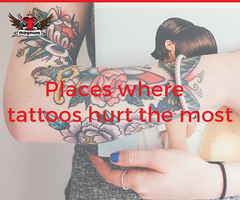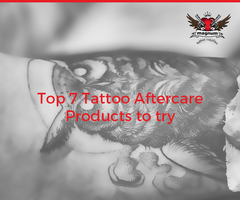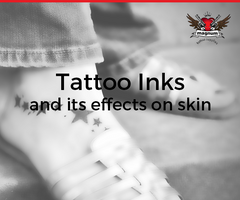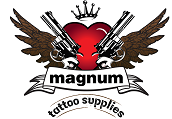Places Where Tattoos Hurt Most 0

Rule of thumb is, the thinner the skin, the more it hurts. Having said that, pain is temporary, but tattoos are forever.
Before getting a tattoo, you should have already accepted the fact that the process will hurt, especially if it is your first time. This might be one of the reasons why people don’t get a tattoo. But don’t let that fear hinder you from expressing yourself with body art. Once you set your mind to it and prepare for the tattooing process you'll find that your body has the ability to withstand the pain under most circumstances. It is really important to be extra sure of your decision, you have to make sure that it is really what you want.
Being informed is important. Below are five spots where placing a tattoo hurts the most.
Behind the Ear
Knowing the area around the ear having thin and delicate skin is an obvious cause that this tattoo placement is going to hurt a lot more. This area is very sensitive since it does not have much fat. However, don't let that stop you from inking an easy to conceal design. Whether it be a single phrase or an insect tattoo, your tattoo artist can help numb the anticipated pain with a specialised cream. It may be of minimal help, but hey, at least it helps.
Chest
Chest tattoos are a popular choice for both men and women. Either way, most chest piece tattoos are going to be painful unless you have lots of body fat or muscle. If you're skinny or of small frame, be prepared to endure a little more for your Old School swallow tattoo.
Ribs
Getting tattooed on the rib cage is considered one of the most painful spots to get inked. Due to each person’s unique size, shape and natural curves, rib cage tattoos can also be more challenging for tattoo artists. However, the rib cage offers a beautiful spread of canvass. The thin skin, however, across the ribs can cause quite a bit of a challenge for those being tattooed. You may find starting small and then gradually adding to a side rib cage design is the best way to test the waters first.
Ankle
When you get a tattoo made on your ankle, you can feel the reverberations and the friction of the needle throughout your feet. It won’t feel like tickling, it is pain; real pain. Even a small tattoo could hurt so much, since there is nothing but bone in your ankle. Delicate as they may seem, ankles pull their weight as one of the hurtful spots to ink regardless of their size.
Foot
A lot may testify that getting a foot tattoo is the least option a tattoo artist may give you since it gives uneven and poor healing results, not to mention the pain that comes with this placement. The feet and toes are all about bones. When you are getting a tattoo done on your feet, the needle will hit the bones and it will most definitely hurt a lot. The foot has a small distribution of body fat so you'll feel much more of the process. But that doesn't mean a dragon character or a minimal feather won't always look gorgeous, so have at it if you must.
- Matthew Nelson
- Tags: blog foot tattoo health people with tattoo tattoo blog tattoo enthusiasts tattoo healing tattoo ink tattoo tips
Top 7 Tattoo Aftercare Products to Try 0

Maintaining the look of your tattoo may seem easy, but just like any other things... tattoos fade after a certain time. This is why manufactures in the tattoo industry came up with tattoo aftercare products to help heal your tattoo while maintaining it's vibrancy.
Here are some of the best tattoo aftercare products for healing, moisturising and enhancing the look of your tattoos.
1. Tattoo Goo original aftercare salve 3/4 Ounce tin
This aftercare product comes from 100% natural ingredients. It is made with herbs, vitamins, and oils known for their healing properties. Using this product allows the skin to breathe and soothe during your tattoo's healing process. Tattoo Goo original aftercare salve is also useful for the skin that is damaged, chapped, scraped and sun or wind burned.
2. Landerm transparent film tattoo aftercare
Landerm transparent film adhesive tattoo dressing keeps your skin away from water, germs and dust while still letting your skin breathe. It is a hypoallergenic adhesive protective barrier designed to speed up recovery of your new tattoo. It's an adhesive dressing that is also light and flexible that provides ultimate comfort. It can also be cut out to adjust to the tattoo size.
3. Ink Fixx tattoo aftercare ointment
Ink Fixx Tattoo aftercare ointment is one of the highest rated tattoo aftercare product on Amazon. It contains all of the necessary vitamins and minerals needed to allow the tattoo to heal fast and naturally. This ointment should be applied daily for your tattoo to avoid cracking, scabbing, or peeling. It also helps to avoid your tattoo’s colour to fade. It is completely based on natural ingredients, making it gentle on skin.
4. Tattoo Goo’s tattoo Kit
Getting the whole kit gives you a great deal. With an affordable price, this tattoo aftercare kit consists of five different products made by Tattoo Goo. Among these five aftercare products are moisturising lotion, soap, ointment, and a lot more. The kit is proven to be one of the best products that can heal your new tattoo. You can use it as skin moisturiser, tattoo healer, soother and infection preventer.
5. H2Ocean Extreme tattoo care kit
This product is one of the most recommended tattoo aftercare products by tattoo professionals worldwide. The 3- step ointment based system is known for its first aid healing process. Just like any other aftercare product, it keeps and protects the colour of your tattoo for a long time.
6. After Inked Tattoo Moisturiser and aftercare lotion
After Inked product is made to moisten your new and existing tattoo. This all- natural product helps your tattoo look and feel healthier. It is also non-petroleum based, paraben-free, fragrance-free, vegan, cruelty-free and gluten-free. This clinically- tested product is safe on all skin types, and is non- irritant.
7. A&D Ointment Element tattoo aftercare medical supply
Inside the package are 144 individual packs. It is used during the tattooing process as a skin moisturiser but it can also be used as a tattoo aftercare lubricant / moisturiser.
Tattoo Tools: Autoclavable or Disposable? 0
 Being a tattoo artist means being responsible for your client’s safety and satisfaction. One of the things a tattoo artist considers before starting their own tattoo business is whether to use autoclavable tools or disposable ones. Tattoo tubes, tips and grips are essential components in every tattoo artist's toolkit, so it's important to choose carefully and pick supplies that are economical without sacrificing quality.
Being a tattoo artist means being responsible for your client’s safety and satisfaction. One of the things a tattoo artist considers before starting their own tattoo business is whether to use autoclavable tools or disposable ones. Tattoo tubes, tips and grips are essential components in every tattoo artist's toolkit, so it's important to choose carefully and pick supplies that are economical without sacrificing quality. Pros and Cons of Autoclavable and Disposable Tattoo Tubes, Tips and Grips
Once you know all the pros and cons, you will have a better idea on whether to choose disposable or autoclavable tips, tubes and grips.
When purchasing disposable types, everything comes in a package, including the grip, tube, and tip. On the other hand, autoclavable tools are often sold separately. Buying tools separately might sound like a burden, but it can actually be a beneficial. There are actually several benefits in purchasing reusable tattoo grips, tips and tubes separately that may outweigh the convenience of all-in-one disposable units. The difference between an autoclave and disposable type are pointed out below.
- Minimal Equipment Needed
- The Cost Factor
- Customizability
Before you start narrowing down your options, you need to know what your choices are as well as the benefits and drawbacks of each option. I hope the comparison I've shared above helps you determine which one will work best for you.
Tattoo Inks and its effects on skin 0

They say wear your heart on your sleeve, but other people choose to wear it on their skin. For some, tattoos are a way of expressing a part of who they are. Aside from that, tattoo is a great form of art. Having a tattoo may not be everyone’s cup of tea because of the risks that come with it. With so much articles written online, it's pretty confusing which ones to take seriously. One of the commonly discussed factor that scares most people who haven't had a tattoo is the ink and the components used to create it.
Tattoo ink is a liquid that contains one or more colourants and other ingredients in the form of adjuvants, such as binding agents, additives and solvents. It is abundant of different chemicals. This is why every tattoo ink is different and might have different effects on the skin. If you get two tattoos in the exact shade, but get them at different times and from different artists who use different inks the chemical compositions probably won’t match. Tattoo inks include pigments, which can contain a variety of metallic salts, like oxides, selenides, sulfides, organic dyes, or plastics, and the carriers with which they are mixed to help provide an even application of the ink.
Inks are usually either alcohol-based or water-based. It may include ethanol, methanol, and glycerin products as mediums for transferring the pigments in the inks. Below are some of the benefits that these types of tattoo inks contain.
- Non- toxic inks
Non- toxic inks are made from organic pigments. It has been developed recently, after certain chemicals previously used to make traditional tattoo inks were linked to cancer. This type of tattoo ink is different since their pigments are all made from ingredients that come straight from nature.
- Water based tattoo inks
Water- based inks produce flexible, dynamic pigments in reliably bold, beautiful colours.
- Vegan tattoo ink
Another type of tattoo ink that is now popular to the majority is the vegan tattoo ink. These inks don’t use any type animal by-products for colour or carrier solutions. Using a vegan tattoo ink is beneficial because it lasts longer compared to regular inks. The ink does not contain chemicals that are harmful for your skin, and for your tattoo artist's health. Research also shows that tattoos with vegan and non-toxic inks have faster healing time because of it's natural ingredients.
- Glow in the dark and backlight tattoo ink
Both inks have been used for tattooing. Glow in the dark ink absorbs and retains light and glows in darkened conditions by the process called phosphorescence. Blacklight ink does not glow in the dark, but reacts to non-visible UV light, which produces a visible glow by fluorescence.
- Black henna
Black henna is normally applied externally for temporary “Mehandi” tattoos, rather than being injected beneath the skin as a permanent tattoo. It is a temporary tattoo that has an ingredients that can also be found on hair dyes.
Recommended Tattoo Aftercare Tips 0

It is important for anyone to properly take care of their skin after getting a tattoo, to avoid infections and complications. Usually tattoo takes two full weeks to properly heal. The following recommended tips will help you take care and heal your fresh tattoo. By following these simple tips, your tattoo will heal at a quicker pace, look wonderful, and reduce the risks of having infections.
- What to do after getting a tattoo: After you get a tattoo, the tattoo artist will clean and bandage your tattoo. The bandage will be removed after at least 2-3 hours, or once you arrive home from the tattoo shop. The reason for this is to seal up the traumatised skin and to prevent the coming out of lymphatic fluid and blood. When it is already time for you to remove the bandage, gently wash your new tattoo by using an anti-bacterial and non-abrasive soap. Do this for at least two weeks. Using a wash cloth is prohibited unless your tattoo is already fully healed. Wash it using your hands and avoid scrubbing it. It would be better if you cover your tattoo with a loose-fitting, protective clothing, rather than having it redressed with a bandage.
- What to do during healing:
- Bathing: Careful handling of your tattoo should be done in the first 2-3 days while taking a bath. Never soak yourself in a hot tub, take a hot shower, or go to steam and sauna rooms. The hot water will open your pores and take out the impurities in your skin, including the tattoo ink pigment. Just use lukewarm water and minimise your time in the shower.
- Swimming: During the first week of your tattoo, avoid swimming, soaking yourself in a Jacuzzi or bath tub. These are possible sources of bacteria and other foreign substances that might infect your tattoo. The only time you can start swimming is when your tattoo has fully healed. Swimming while still scabbing can cause loss of pigment, which can make your tattoo look unattractive.
- Tanning/Sunlight: Eventually, your tattoos will fade. However, prolonged exposure to UV rays, will make it fade faster. Avoid too much exposure from the sun and tanning beds. In order to make your tattoo look great throughout the years, limit your exposure to direct sunlight or if it really can’t be avoided, apply sunscreen to the tattoo.
- If during the healing process your tattoo becomes irritated, red, itchy or secretes fluid, see your doctor immediately.
- How about anti-bacterial ointments? Since a tattoo is an open wound, it is more prone to bacterial infection. Taking the fundamental preventative measures and practising good hygiene will significantly reduce the chances of having serious infections. For the first 2-3 days, apply a thin layer of antibacterial ointment to the tattoo. This must be done repeatedly throughout the day in order to make sure that the tattooed area of the skin does not dry up and be infected. Bacitracin, which can be found in the first aid section of your local drugstore, is a recommended medicine. Wear loose-fitting clothes in order to allow the tattoo to breathe.
Choosing the Right Power Supply 0

A tattoo may represent a lot of things. It is not just the window to a person’s personality, it also shows how the tattoo artist interpreted their client's design. Tattoo artists who care for their clients, and who make an effort to know the needs and wants of the customers will go a long way.
A great tattoo artist gives only the best service to their clients. The make sure they have the right skills and the right equipment. This also includes the equipment used to power their machines.
Here are some of the things you need to check off your "finding-the-perfect-power-supply" list.
1. Determine the voltage required. Tattoo power supplies have a wide range of volt outputs. Some are capable of running as low as 3 and as high as 12 to 15. Some portable power supplies can run to as low as 1.5 volts and larger power supplies can run to as high as 20 volts. Obviously, the higher the voltage would mean more power will be supplied.
2. Choose the type of power supply. Analogue and digital power supplies come in both regulated and unregulated models. Your confidence level and power output reading are factors in choosing the right power supply. It is very important to look at each type available. A digital power supply gives a more accurate reading. The power is easier to check and see, even while you’re working. However, digital power supplies are more expensive. Regulated machines are pricey, but it provides you with a constant voltage even if the tattoo machine isn't running.
3. Consider the fluctuations. The amount of power required at any given time during a tattoo may change depending on the amount of pressure being applied as the tattoo needle pierces the skin. Many regulated machines will help compensate for these fluctuations. Other machines do not. Ask, research, and pick which power supply you feel most comfortable with.
4. Take into consideration your regular tattoo machine. Some tattoo power supplies are only recommended for a coil operated tattoo machine, while others can be used for a rotary machine and still others can be used for both.
5. Think of the number of machines you can hook up. Many tattoo artists prefer to set up a separate machine for lining and another for shading. It's convenient to have a power supply that allows you to plug in two machines at once and just flip a switch to change while the tattoo session is ongoing.
6. Contemplate size, weight and portability. A small tattoo power supply doesn’t automatically mean the power is suppressed. A lot of manufacturers sell compact units for those who want to save space, or for the tattoo artists who travel often.
7. Factor in price. Before deciding if the price is right, carefully take into consideration all of the factors above. You may be able to find more than one reliable machine that meets or exceeds all of your needs. If this is the case, then you start eliminating based on price.






